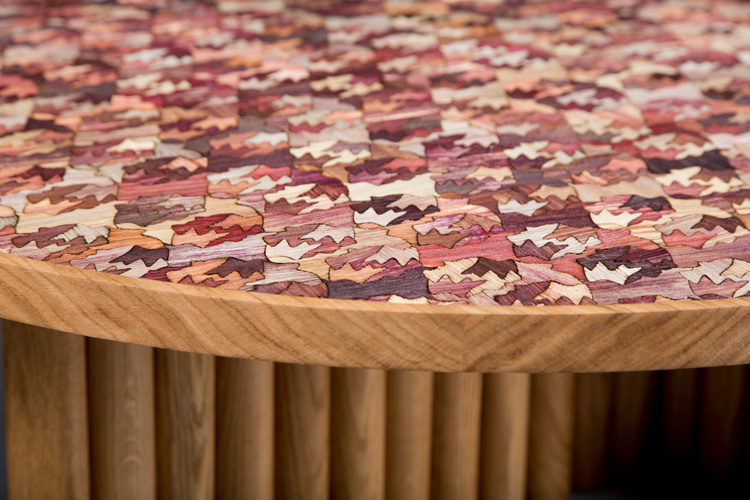How a new generation of designers is creating social impact
From circular economies within fashion to rehabilitating indigenous communities, a crop of young designers are focusing on design’s capacity for social change.
The fashion industry has long been seen as a problem — from poor working conditions to its environmental impact.
But Bethany Williams, a fashion designer from Kent, believes it is a question of reframing the industry. Her eponymous brand aims to “engage with communities” and create “circular systems” to benefit communities and encourage exchange in an attempt to combine both social good and sustainability.
The British designer is one of four finalists for the Arts Foundation Futures Awards, which features projects for social impact. This year, the 20 longlisted projects were also all sustainability-themed, with most looking at how to deal with waste.
“New systems within fashion”
Williams has now produced several socially-focused fashion collections. Her first project after finishing her masters at London College of Fashion was with San Patrignano, a drug rehabilitation centre in Italy with a particularly high recovery rate. The centre has over 1,200 members, who work in various areas of craft making.
Williams worked with the San Patrignano’s textile department, making woven materials with thirty women at the centre. The designer took waste from other departments at the centre, wove them into a new fabric, which she then used for her fashion collections. Proceeds from her collections are then given to the charities which have helped make them. It’s all part of creating “new systems within fashion”, Williams says.

Oftentimes, there will be too much demand for the limited availability, which means they will have to add new colours for a collection. But Williams says that this is an advantage, as stores like it when they have access to an “exclusive colourway”.
Williams works with a charity for each of her fashion collections and chooses charities with issues she wants to talk about. She is currently creating a manifesto to “check herself” as her business scales up and she’s approached by companies seeking potential collaboration.
How aesthetic value and social good can align
Another finalist, Fernando Laposse, also focuses on community. His veneer material Totomoxtle is inspired by the village of Tonahuixtla in Mexico, which the designer visited as a child.
Aggressive farming techniques — which rely heavily on herbicides — have decimated the native varieties of corn in the village. This means that the local indigenous population has also suffered from a decline in employment. Laposse’s project works with the community of Tonahuixtla and CIMMYT, the world’s largest corn seed bank, to repopulate the land with native species.

Totomoxtle is then made from the husks collected by these corn harvests. The veneer’s manufacturing process creates employment for the community’s women, the population that has been left behind following mass migration of men to work in America.
A problem around social design is often that it is not consumer-driven. While people might say that they are environmentally-focused and like socially-driven products, this is not always reflected in purchasing habits.
Because of this, Laposse made the aesthetic value a focus for the project. These veneers can be produced in various colours and finishes — from purple to creams. He is currently in talks with a French furniture designer to use the veneer.

The possibilities of product design
Among the finalists, there is also a focus on product design to solve social issues.
Lewis Hornby’s product, Jelly Drops, is inspired by his grandmother’s struggle with dementia. After she experienced a sharp decline in health, the family realised it was because she had simply not drunk enough water — a habit that is easily forgotten and presents significant motor challenges. This problem is widespread; the leading cause of death for dementia patients is dehydration.

Jelly Drops are a colourful gelatinous edible product consisting of 90% water, which are appealing to patients as they look like sweets. They are also easy to pick up and break down quickly so can be consumed easily. His grandmother ate seven drops in 10 minutes during testing; an entire box of Jelly Drops would be the same as drinking three cups of water.

Jack Herring meanwhile has created a Soluboard, a soluble printed circuit board (PCB) in an attempt to reduce electronic waste. PCBs were previously made of fibreglass and epoxy, meaning that the waste process involved shredding an incineration – often in international territories such as Ghana, which has one of the largest electronic waste dumps in the world at Accra’s Agbogbloshie.
Soluboard is made of fully biodegradable flax which delineates in hot water. Focusing on the white goods and domestic markets, it is also a competitively priced material.
“We’ve got to change the way we work”
While the projects vary, a shared theme is the problem of scaling up. Hornby’s Jelly Drops are currently not available to buy, Laposse’s work is located in one village (though he has begun collaboration with another indigenous population), Williams faces the fashion industry where giants like H&M dominate the supply chain, and Herring’s Soluboard is looking to secure more funding.
The eventual winner of the Arts Foundation Futures award will be announced in January 2020, with a prize of £10,000. Apart from this competition funding, the solution to creating sustainable businesses out of socially-driven ideas is not clear.
Rebecca Earley, a judge for the competition who works to embed circular economies within corporate companies such as H&M, says that one answer to long-lasting businesses might be an “anti-competition” culture where industries learn to communicate better and share ideas.
“We’ve got to change the way we work,” she adds.
-
Post a comment





